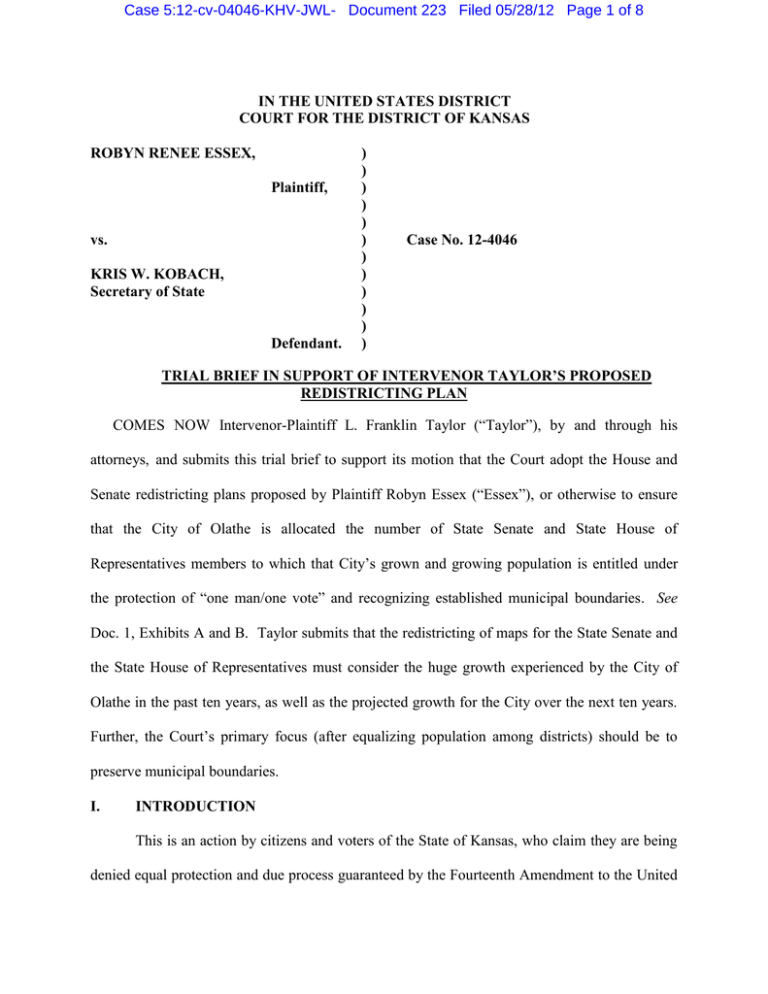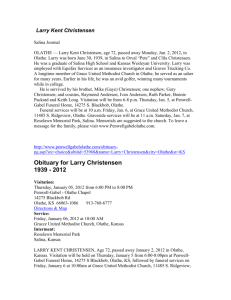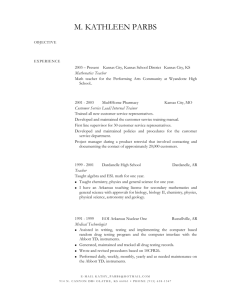IN THE UNITED STATES DISTRICT COURT FOR THE DISTRICT OF KANSAS
advertisement

Case 5:12-cv-04046-KHV-JWL- Document 223 Filed 05/28/12 Page 1 of 8 IN THE UNITED STATES DISTRICT COURT FOR THE DISTRICT OF KANSAS ROBYN RENEE ESSEX, Plaintiff, vs. KRIS W. KOBACH, Secretary of State Defendant. ) ) ) ) ) ) ) ) ) ) ) ) Case No. 12-4046 TRIAL BRIEF IN SUPPORT OF INTERVENOR TAYLOR’S PROPOSED REDISTRICTING PLAN COMES NOW Intervenor-Plaintiff L. Franklin Taylor (“Taylor”), by and through his attorneys, and submits this trial brief to support its motion that the Court adopt the House and Senate redistricting plans proposed by Plaintiff Robyn Essex (“Essex”), or otherwise to ensure that the City of Olathe is allocated the number of State Senate and State House of Representatives members to which that City’s grown and growing population is entitled under the protection of “one man/one vote” and recognizing established municipal boundaries. See Doc. 1, Exhibits A and B. Taylor submits that the redistricting of maps for the State Senate and the State House of Representatives must consider the huge growth experienced by the City of Olathe in the past ten years, as well as the projected growth for the City over the next ten years. Further, the Court’s primary focus (after equalizing population among districts) should be to preserve municipal boundaries. I. INTRODUCTION This is an action by citizens and voters of the State of Kansas, who claim they are being denied equal protection and due process guaranteed by the Fourteenth Amendment to the United Case 5:12-cv-04046-KHV-JWL- Document 223 Filed 05/28/12 Page 2 of 8 States Constitution because of the failure of the Kansas Legislature to comply with constitutional requirements of re-apportioning the Congressional and Legislative district boundaries, as well as the district boundaries for the Kansas State Board of Education. The plaintiffs and the defendant have the same goal, the adoption of a constitutional plan. However, the parties advocate different means to that end. Intervenor-Plaintiff Taylor, a citizen and voter residing in the City of Olathe, Kansas, respectfully submits that this Court must adopt a plan that eschews drawing lines for the sake of polarity (helping political candidates), and instead a plan that draws lines for the sake of community – helping voters. As such, Taylor submits that the Legislative redistricting plan that is adopted must account for the cohesiveness, common interests, and anticipated population growth of the City of Olathe. Taylor suggests that that the Essex Senate and House Plans appropriately take into consideration these important factors, as they relate to the City of Olathe. Alternatively, regardless of the plan adopted or drawn by the Court, Taylor requests that the lines for the City of Olathe protect its citizens’ right to six (or at least five-plus) representatives and two senators. II. ARGUMENTS AND AUTHORITIES This Court has broad discretion in choosing an appropriate redistricting plan. See O’Sullivan v. Brier, 540 F.Supp. 1200, 1202-03 (D. Kan 1982)(the Court may adopt a proposed plan in whole, adopt a proposed plan with modifications, or the Court may create a new plan). The predominant constitutional requirement is that the plan “must make ‘as nearly as is practicable one man’s vote in a congressional election be worth as much as another’s.’” Id. at 1203 (quoting Wesberry v. Sanders, 376 U.S. 1, 7-8 (1964)). However, where a number of proposed plans achieve similar levels of population equality, courts consider additional factors in choosing an appropriate and fair plan, including Case 5:12-cv-04046-KHV-JWL- Document 223 Filed 05/28/12 Page 3 of 8 “(1) whether a proposed plan preserves county and municipal boundaries, (2) whether a plan dilutes the vote of any racial minority; (3) whether a plan creates districts that are compact and contiguous, (4) whether a plan preserves existing congressional districts; and (5) whether a plan groups together communities sharing common economic, social, or cultural interests.” Id. at 1203 (internal citations omitted); see also, e.g., Smith v. Clark, 189 F.Supp.2d 529, 540 (S.D. Miss 2002); Kirkpatrick v. Preisler, 394 U.S. 526,535 (1969); Carstens v. Lamm, 543 F.Supp. 68, 88 (D. Colo. 1982). Of these, this Court “attach[es] great importance to the preservation of county and municipal boundaries.” O’Sullivan,, 540 F.Supp. at 1203. Taylor respectfully asks the Court to consider the City of Olathe’s municipal boundaries when choosing House and Senate redistricting plans. The Court should also consider the importance of preserving Olathe’s common interests and the speed of its population growth. A. Recognition and Respect for the City of Olathe’s Municipal Boundaries. Taylor asks the Court to be mindful of Olathe’s municipal boundaries and to refrain from splitting Olathe among multiple districts. The Supreme Court has recognized that respect for municipal boundaries is an important goal. See Karcher v. Daggett, 462 U.S. 725, 740 (1983). This factor can even justify minor population deviations between districts. Id. (citing West Virginia Civil Liberties Union v. Rockefeller, 336 F.Supp. 395, 398-400 (S.D. W.Va. 1972)). Part of the reasoning for this consideration is that [s]ubdivision boundaries tend to remain stable over time. Residents of political units such as townships, cities, and counties often develop a community of interest, particularly when the subdivision plays an important role in the provision of governmental services. In addition, legislative districts that do not cross subdivision boundaries are administratively convenient and less likely to confuse the voters. Id. at 758 (Stevens, J., concurring). Likewise, this Court has stated its goal of preserving municipal boundaries when adopting redistricting plans and took this consideration into account Case 5:12-cv-04046-KHV-JWL- Document 223 Filed 05/28/12 Page 4 of 8 when making its redistricting decision in 1982. See O’Sullivan, 540 F.Supp. at 1203. Further, the Kansas Legislative Research Department’s own guidelines – which have been approved by both the Senate and House – state that the “integrity and priority of existing political subdivisions should be preserved to the extent possible” and “[d]istricts should be easily identifiable and understandable by voters.” Guidelines and Criteria for 2012, Kansas Congressional and Legislative Redistricting, January 9, 2012. The City of Olathe is a cohesive unit. Its political boundaries are known to its residents. Olathe’s residents share goals of community advancement and development. Further, the City provides its residents their police and fire protection; their water, sewer, and solid waste handling; their public safety and emergency preparedness; and their streets, lights, and parks. Olathe’s residents count on the City of Olathe to provide these services and further the community interests. By dividing their representatives between the City and other municipalities, many of the proposed plans do not provide for easily identifiable or understandable districts for the voters; the political boundaries of the City of Olathe are not preserved under these plans. Moreover, such division dilutes the community advancement and development interests shared by the City of Olathe’s residents. As such, the House and Senate redistricting plans adopted by the Court should respect the municipal boundaries of the City of Olathe. The Essex House and Senate plans advanced by Taylor support this important goal and should be adopted by the Court. B. Preserving Communities of Interest. In adopting redistricting plans, courts also attempt to preserve communities of common interest, recognizing that maintaining such communities serves a vital civic function. Such communities should be maintained if possible as they are the basis of person’s sense of Case 5:12-cv-04046-KHV-JWL- Document 223 Filed 05/28/12 Page 5 of 8 commonality and “tend to foster effective representation.” Carstens v. Lamm, 543 F.Supp. 68, 88 (D. Colo. 1982). This principle is important because it recognizes the importance of shared local experiences and the ability of groups and candidates to “network” within their communities. Thus, a state has a substantial interest in preserving city and county lines. South Carolina State Conf. of Branches v. Riley, 533 F.Supp. 1178, 1180 (D.S.C. 1982), aff’d, 459 U.S. 1025 (1982). Preserving these communities of interest also enables a congressman to represent his constituency better. Therefore, the aim is to preserve compatible political interests. See Carstens, 543 F.Supp. at 88; LaComb v. Growe, 541 F.Supp. 145, 148 (D. Minn.1982), aff’d, 456 U.S. 966 (1982). Arizonans for Fair Representation v. Symington, 828 F.Supp. 684, 688 (D. Ariz. 1992). In densely populated areas, such as Olathe, maintenance of municipal integrity is vital as “[t]hese local units of government represent logical centers of community interest for urban residents who identify more closely with municipal rather than county services.” Carstens, 543 F.Supp at 88. As discussed supra, residents of Olathe share common goals relative to their shared space, needs, and services. The City of Olathe’s shared interests should be preserved by allocating representatives that will support and advocate for those shared interests rather than dividing up those representatives’ interests between multiple municipalities outside of the City of Olathe’s boundaries. The Essex House and Senate plans advanced by Taylor will properly align the citizens of Olathe with their representatives. Accordingly, they should be adopted by the Court. Again, Taylor alternatively requests that, when the Court adopts or draws a plan, the City of Olathe’s congregated municipal interest is taken into account such that lines are drawn to allocate specific senate and house districts to the boundaries of that City. Additionally, to the extent it becomes necessary to extend beyond the borders of the City of Olathe to round out district population, this community of interest extends to those citizens who are not located within the City of Olathe, but who are served by the Olathe School District (Unified School District 233). See http://maps.jocogov.org/ims/?z=11&ll=38.895,- Case 5:12-cv-04046-KHV-JWL- Document 223 Filed 05/28/12 Page 6 of 8 94.83&op=0.5&ls=vm&bm=0. The City of Olathe has spent years developing and investing in a cooperative working relationship with the Olathe School Board, leading to a symbiotic, mutually beneficial partnership, involving some 35 different cooperative programs which bring students into direct and positive contact with the City, and by which the City provides valuable assistance to the schools. See http://www.olatheks.org/files/cmo/2012CombinedCollaborationReport.pdf. Thus, recognizing and taking into account civic boundaries would justify using USD 233 as an additional factor in adding voters to those within the City of Olathe in drawing lines for the Kansas State Senate and the State House of Representatives. C. Anticipated Population Growth. Additionally, it is important for this Court to take into account that the plan it adopts will be in effect until after the next Census is taken in 2020. The Supreme Court has explicitly affirmed the principle that “[s]ituations may arise where substantial population shifts over such a period can be anticipated. Where these shifts can be predicted with a high degree of accuracy, States that are redistricting may properly consider them.” Kirkpatrick, 394 U.S. at 535. Findings as to population trends are sufficient to support the Court’s consideration of disparate population growth rates when redistricting. Id. As recognized by the Court in Kirkpatrick, the likelihood that a certain area will grow faster than its neighbors should be accounted for. This Court has also recognized that significant disparity in population growth rates has the potential for a substantial impact on the lodestar of the Court’s focus in redistricting – one-person, one-vote. See O’Sullivan, 540 F.Supp at 120607. Considering that the redistricting plan will be in effect for many years, the Court should take into account areas of the State that are expected to grow significantly faster than its neighbors and plan accordingly. Case 5:12-cv-04046-KHV-JWL- Document 223 Filed 05/28/12 Page 7 of 8 The City of Olathe’s population in the year 2000 was 93,012. See Mid-America Regional Council (MARC); U.S. Census Bureau. By 2010 it had grown dramatically to 125,872, a growth rate of over 35%. Id. In fact, the City of Olathe was the fastest growing city in Johnson County and the second fastest growing city in the entire state of Kansas in absolute numbers. Id.; see also Joint Exhibit 1; Joint Exhibit 2. Just two years later the City of Olathe’s 2012 population is currently estimated at 127,472. And the City of Olathe has room to grow with hundreds of preliminarily approved and fully approved lots available for residential homes that average four citizens per household. In the first quarter of 2012 alone, there were 98 new single family home permits issued. In 2010 and 2011, the City of Olathe issued 326 and 272 single family home permits respectively. As the economy is recovering, this boom will increase even more. This Court should take Olathe’s burgeoning population and anticipated growth into account when it adopts or drafts a redistricting map. Over the next ten years, the failure to do so will result in the dilution of its residents’ votes and violate the one-person, one-vote rule in violation of the Constitution. This intervenor asks the Court to take this fact into consideration. Case 5:12-cv-04046-KHV-JWL- Document 223 Filed 05/28/12 Page 8 of 8 III. CONCLUSION. For the foregoing reasons, Intervenor L. Franklin Taylor requests that the Court either adopt the Essex House and Senate plan or draft a plan for the redistricting of the State of Kansas for the Senate and the House of Representatives in a manner that recognizes and preserves the municipal boundaries of the City of Olathe as a cohesive municipal unit, that does not divide that city among multiple other, unrelated areas, and that anticipates continued significant population growth with the City of Olathe’s boundaries. Respectfully submitted, SPENCER FANE BRITT & BROWNE LLP /s/ Bryant T. Lamer J. Nick Badgerow # 9138 Michael F. Delaney #22510 Bryant T. Lamer #22722 Lindsay Todd Perkins #23528 9401 Indian Creek Parkway Building 40, Suite 700 Overland Park, KS 66210 (913) 345-8100 (913) 345-0736 (Facsimile) nbadgerow@spencerfane.com mdelaney@spencerfane.com blamer@spencerfane.com ltoddperkins@spencerfane.com ATTORNEYS FOR INTERVENOR TAYLOR CERTIFICATE OF SERVICE This will certify that the foregoing pleading was filed this 29th day of May, 2012, via the Court’s CM/ECF filing system which will in turn serve all counsel of record. /s/ Bryant T. Lamer Attorney for Intervenor Taylor






